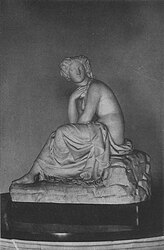Johannes Cappeller
Johannes Georg Cappeller (* 2. July 1827 in Nuremberg ; † 23. August 1883 in Munich ) was a German sculptor of classicism in Stuttgart .
Life
Johannes Cappeller was born on July 2, 1827 in Nuremberg as the son of the architect Georg Cappeller and Clementine Heideloff. The mother was a sister of the architect Karl Heideloff and the painter and copper engraver Manfred Heideloff . Cappeller's younger brother was the sculptor Viktor Cappeller .
From 1845 to 1847 Cappeller studied sculpture at the Munich Art Academy under Ludwig Schwanthaler . In 1850 he moved to Stuttgart at Charlottenstrasse 7. In Stuttgart he was involved in building the Villa Berg (1845–1853) and the Wilhelma (1846–1866). Between 1850 and 1853 he visited Paris and London with his brother Viktor. From 1856 to 1863 he lived with his brother in the Königsbad. He then lived at Jägerstrasse 16, then in the Neckartor area and from 1877 in his own house at Lorenzstrasse 5 (from 1979 Lorenzstaffel). Princess Marie of Württemberg made it possible for him to stay longer in Italy, where Wilhelm I visited him in his Roman studio in November 1858.
Cappeller died on August 23, 1883 at the age of 56 while traveling in Munich.
Works
Source, unless otherwise stated: #Peschel 2010 , p. 63.
In Stuttgart, Cappeller created figures, tombs, memorials and portraits in the classicist style.
- 1853: Neuhausen auf den Fildern , St. Petrus and Paulus or Liebfrauenkapelle ?, "Mother with Child Jesus".
- 1856–1860: Stuttgart, Königsbau , Corinthian capitals and garlands.
- 1857: "Ariadne" or "Seated Sea Goddess", marble, inscribed "J. Cappeller 1857 “, 50 cm high, lost.
- 1859–1862: "Sakondola with the Gazelle" ( Shakuntala with the Gazelle), Carrara marble , 138 cm high, Staatsgalerie Stuttgart . The sculpture shows a young, undressed girl with a gazelle. It depicts Shakuntala, the protagonist of an ancient Indian drama, a hermit who the Indian king Dushyanta discovers while hunting a gazelle.
- In November 1858, King Wilhelm I of Württemberg visited Cappeller in his studio in Rome, where he saw the model of the sculpture. In 1859, King Cappeller commissioned a marble version of the sculpture. In the fall of 1862 the sculpture was finished except for the gazelle. Cappeller traveled to Frankfurt am Main to model the missing gazelle from nature in the zoo.
- 1864: “Die Baukunst”, a statue at the former Olga Fountain in the fountain hall at the corner of Olgastraße 35 and Gaisburgstraße am Olgaeck, after 1949 in the Stuttgart City Lapidarium .
- 1869: Pair of sandstone lions at the entrance to the rose garden near the New Palace in Stuttgart, destroyed in an air raid in World War II.
- 1879: Portrait bust of Carl von Linné , formerly on the 1st floor of the museum building at Archivstrasse 3 in Stuttgart, moved to the Rosenstein Castle Natural History Museum when the building was demolished in 1963 .
- Life-size standing flora.
- "Truth sitting on a lion".
|
|
literature
- Manfred H. Grieb (Hrsg.): Nürnberger Künstlerlexikon . Visual artists, artisans, scholars, collectors, cultural workers and patrons from the 12th to the middle of the 20th century . KG Saur, Munich 2007, p. 215 ( Google Books ).
- Patricia Peschel: The sculptures from Rosenstein Castle. From the collection of King Wilhelm I of Württemberg . State Palaces and Gardens of Baden-Württemberg, Bruschsal 2010, pp. 9, 63–65, 92.
- Gustav Wais : Stuttgart's art and cultural monuments. 25 pictures with city history, architectural history and art history explanations . Kohlhammer, Stuttgart 1954, pp. 32, 79, 121.
Web links
Footnotes
- ↑ The Königsbad was an inn with a bathing establishment and garden at the Neckartor.
- ^ Stuttgart address books 1850–1883.
- ↑ #Grieb 2007 , #Peschel 2010 , pp. 63–65: based on a short personal biography of the artist.
- ^ [Auction catalog] Rosenstein Castle near Stuttgart. Works of art, antiquities, furniture, Ludwigsburg figures, marble figures from the earlier crown estate, etc. other state property . Felix Fleischhauer, Stuttgart 1920, No. 171.
- ^ [Auction catalog] Rosenstein Castle near Stuttgart. Works of art, antiquities, furniture, Ludwigsburg figures, marble figures from the earlier crown estate, etc. other state property . Felix Fleischhauer, Stuttgart 1920, No. 151; #Peschel 2010 , pp. 63–65.
- ^ #Wais 1954.1 , page 121.
- ↑ #Wais 1954.1 , p. 79.
- ^ Report of the State Museum for Natural History in Stuttgart for 1963 and 1964 . In: Annuals of the Association for Patriotic Natural History in Württemberg , year 120, 1965, p. 13 Fig. 1 ( PDF ).
| personal data | |
|---|---|
| SURNAME | Cappeller, Johannes |
| ALTERNATIVE NAMES | Cappeller, Johannes Georg (full name) |
| BRIEF DESCRIPTION | German sculptor |
| DATE OF BIRTH | July 2, 1827 |
| PLACE OF BIRTH | Nuremberg |
| DATE OF DEATH | August 23, 1883 |
| Place of death | Munich |


